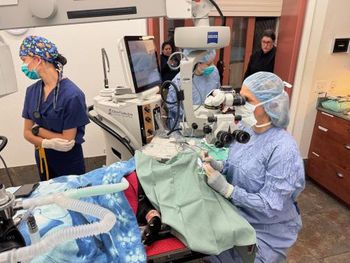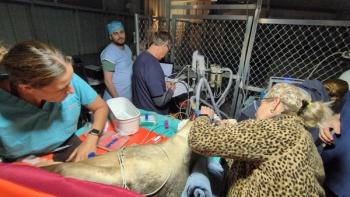
Equine recurrent uveitis (Proceedings)
Herpes virus keratitis
Herpes virus keratitis
• Prevalence:
o EHV-2 has a high overall seropositive rate (90%) that does not have a defined correlation with clinical disease
o Affects foals and adults
• Clinical Appearance:
o Variable pain, blepharospasm, epiphora, edema, vascularization
o Common: classic appearance of multiple multifocal opacities which may be rose bengal positive (superficial erosion) or fluorescein stain positive (superficial ulcer); does not have to have stain retention
o EHV-1 manifestations (blindness, optic neuritis, strabismus) distinctly different
• DDX:
o Influenced by region
o Immune-mediated - Midwest
o Early fungal – primary differential for many
o Other ulcerative – traumatic, foreign body, KCS
o Non-ulcerative keratitis – immune-mediated keratitis, corneal degeneration, calcific band keratopathy
o Conformation difficult – high seropositive in normal population
o Primarily – Rule out diagnosis combined with positive response to tx
o Electron microscopy, virus isolation,
• Pathogenesis:
o EHV-2 is a gamma herpesvirus producing lifelong infections characterized by variable periods of disease recrudescence and latency.
o Reactivation associated with stress (shipping, training, breeding)
o Latency established in lymphocytes and trigeminal and ciliary ganglia
• TX:
o Anti-viral efficacy for equine EHV-2 have not been tested in vivo or in vitro
o Anti-viral medications considered virostatic and must be administered at high frequency (4-6 times daily)
o Topical NSAID
o Topical prophylactic antibacterial
o Systemic NSAID
o Lysine – 10-30 grams orally once daily
o Topical cycloplegic – mydriatic for reflex keratouveitis
o Topical steroid?
• Prognosis: Variable, often taking time and patience
Bacterial ulcerative keratitis
• Prevalence:
o Frequent problem
o Streptococcus, Staphlococcus, Pseudomonas sp.
o Numerous others also reported including anaerobic (clostridium sp)
o Mixed infections, evolving infections common
• Clinical Appearance:
o Non-specific: blepharoedema, pain, epiphora, mucopurulent discharge, corneal opacification
o Specific: stromal involvement will produce cellular infiltration, marked edema, and deepening of the ulcer bed +/- keratomalacia ("melting")
o Anterior uveitis: often severe (hypotony, miosis, flare, hypopyon, synechia)
o Corneal neovascularization
o Vision reduction / loss
• DDX:
o Infectious ulcerative keratitis (fungal, viral)
o Traumatic / foreign body
o Non-infectious ulcerative keratitis (superficial, eosinophilic,
o Non-ulcerative conditions (stromal abscess, immune-mediated keratitis)
o **Perform cytology and bacterial culture / sensitivity
• Pathogenesis:
o Loss of the epithelial barrier allows pathogenic and non-pathogenic bacteria to invade the stroma
• Protease production by bacteria, epithelial cells, inflammatory cells, and stromal fibroblasts results in extensive keratomalacia
• MMP-2,MMP-9, neutrophil elastase
• Medical TX:
o Control inflammation, control infection, control pain, decrease proteolysis
o Placement of subpalpebral lavage system
o Topical antibiotic selection based on culture; administered q 2-6 hours
• Gram Negative – aminoglycosides, chloramphenicol (not for Pseudomonas sp.), ciprofloxacin, ofloxacin, neomycin / polymyxin B
• Gram Positive - chloramphenicol, mofloxacin, neomycin, bacitracin
o Topical mydriatic – cycloplegic (1% atropine)
• Reduces risk of posterior synechia and secondary glaucoma
• Degree of mydriasis correlates with degreed of cycloplegia
√ More severe reflex keratouveitis requires more frequent tx
o Systemic NSAIDs –
• Flunixin meglumine (1.1 mg / kg) PO or IV q 12 hrs
• Taper dose with control of disease
√ Often tapered too soon
o Systemic steroids – not preferred due to increased risk
o Omeprazole (Gastrogard) –
• preventative dose = 2 mg/kg PO qd
• treatment dose = 4 mg/kg PO qd
o Topical antiproteases – Used to control upregulated protease activity
• Autologus serum: serine protease entrapment
• EDTA 0.2%: calcium / zinc chelation of MMPs
• Tetracyclines: Ca / Zn chelation of MMPs (can also be oral)
• N-Acetylcysteine 5-10%: Ca / Zn chelation of MMPs
o Oral / parenteral antibiotics
• Penetration of drug into tear film, cornea, and anterior chamber unknown
• Corneal neovascularization and inflammation may increase drug delivery
• TMS, Potassium Penicillin, Gentamicin
• Doxycycline –
√ Antibiotic
√ Anti-inflammatory
√ Anticollagenolytic
√ Studies:
• Healthy @ 10 mg/kg BID x 5 days – drug not found
• Healthy @ 20 mg/kg BID x 5 days – drug found intraocular
• Healthy @ 20 mg/kg QD x 5 days – drug found in tears
o Subconjunctival antibiotic / mydriatic – not ideal
• Incited inflammatory response
• Limited space
• Unpredictable drug bioavailability as often need 2-3 times daily tx to achieve topical levels
• Surgical TX: Utilize when medical tx delayed or ineffective
o Provides:
• Immediate vascular supply
√ Growth factors
√ Fibroblasts
√ Protease inhibitors
• Structural support
o Indications:
• Ulcers with ≥ 50% stromal loss
• Ulcers with ≤ 50% stromal loss but associated with progressing malacia
• Descemetocele
• Corneal perforation / iris prolapse
• Monitor level of uveitis
o Procedures:
• Conjunctival grafts (pedicle, bipedicle, hood, free island, bridge, 360°)
• Lamellar corneal grafts (corneoscleral or corneoconjunctival transposition)
• Natural (amnion, autologous cornea) or synthetic/biosynthetic tissue (A-Cell, Biosys) grafts
o After sx, medical tx should continue as previously administered
• Prognosis: Variable!
o Must control infection, corneal digestion, and associated inflammation
o Different studies found 50-76% rate of visual success with a comfortable eye
Fungal ulcerative keratitis
• Prevalence:
o Regionally frequent (warm months, humid climates)
o Regional species variability – need for culture / ID
• Clinical Appearance:
o Superficial keratomycosis
• Microerosion
√ Multifocal subepithelial whitish opacities
√ Rose bengal positive +/- ulceration
• Epithelial devitalization
√ Pain, secondary uveitis variable
• Superficial ulceration
√ More severe presentation
√ Defined epithelial loss with white / yellow cellular infiltration
√ Pain, secondary uveitis, neovascularization variable
• Plaque formation ("cake-frosting" appearance)
√ Whitish-yellow necrotic plaque of stroma with ulceration
o Stromal ulcerative keratomycosis – most common; 50-80% of cases with even more severe pain and anterior uveitis
• Corneal furrowing
√ Curvilinear region of stromal loss @ ulcer edge
√ Rapidly occurs @ any time
• Melting
• Perforation
o Stromal abscess
• DDX: Cytology; cultures (bacterial / fungal); PCR?
o Trauma / foreign bodies
o Infiltrative ulcerative diseases
• Bacterial
• Eosinophilic
• Herpesvirus
• Immune-mediated
o Mixed bacterial / fungal
• 20-35% of infectious cases
o Calcific band keratopathy
o Corneal degeneration
o Corneal neoplasia
• Pathogenesis:
o Loss of the epithelial barrier allows ocular surface and environmental fungal organisms to adhere, invade, and infect the stroma
o Protease production by fungii, epithelial cells, inflammatory cells, and stromal fibroblasts results in extensive keratomalacia
o Fungal organisms have been shown to inhibit in vitro angiogenesis
o Deep stromal disease perpetuated by fungal affinity for the glycosaminoglycans near Descemet's membrane
o Predisposing factors
• Topical antibiotics
√ Healthy gram-positive microflora which produces balanced antifungal and antibacterial substances shifts to gram-negative in corneal ulcers
√ Antibiotic use can exacerbate this use
• Topical steroids
• Not all factors understood
• Studies
√ 1998 UF (Andrew S): Fungal cases - 82% received topical AB; 15.4% received topical steroid prior to referral
√ 2009 (Galan A): Fungal cases - 60% received topical AB; 20% received topical steroid prior to referral
• Medical TX:
o Target fungi, secondary bacterial infection, corneal digestion, secondary anterior uveitis, and ocular pain
o Antifungal medications:
• Most antifungal drugs = fungistatic because of an inability to achieve adequate concentrations in the presence of an intact corneal epithelium
√ Epithelial loss – increases drug concentration
√ High frequency administration – increases drug concentration
• Aggressive frequency
√ Does this result in clinical deterioration?
• Intense inflammatory reaction
√ Potential weighed against primary disease
• Therapeutic debridement
√ Increase drug penetration
√ Debulk organism
• Three general antifungal classes
√ Polyenes:
• Preferentially bind ergosterol, cell membrane sterol unique to fungi
• Increases cell permeability and leakage; oxidative damage
• Able to bind to cholesterol, mammalian membrane sterol potentially creating toxicities
• Broad spectrum
• Best for ulcerative disease
• Good efficacy against filamentous and yeast fungi
• Frequency: q 2-4 hrs initially, then taper
• Amphotericin B:
o Topical 0.075 – 0.2% solution in sterile water; refrigerate, dark bottle
o Increased epithelial toxicity vs Natamycin
o Subconjunctival – 0.2 mL of 5 mg / mL solution q 48 hrs for 3 doses
• Natamycin:
o 5% suspension
o Only commercial ophthalmic antifungal
√ Azoles:
• Preferentially binds to fungal specific enzyme in the cytochrome P450 system
• Inhibits ergosterol synthesis, increases membrane permeability, alters fungal cell enzyme systems
• Frequency: q 2-4 hrs initially, then taper
• Imidazoles
o Ketoconazole: 1%
• Best for ulcerative disease
• Poorer efficacy than other azoles
o Miconazole:
• Topical 1%
• Good penetration through intact epithelium
• Subconjunctival 1% - 5 to 10 mg q 24 to 48 hrs
• Triazoles
o Fluconazole:
• Topical 0.2% solution
• Poorer efficacy vs other azoles against filamentous and yeast organisms
• Systemic = 14 mg / kg PO once, then 5 mg / kg PO q 24 hrs
• Good intraocular penetration with or without inflammation
• More limited spectrum than other azoles
o Itraconazole:
• Topical 1% in 30% DMSO suspension
• Good penetration through intact epithelium
• Systemic = 1.5 mg / kg IV q 24 hrs; 5.0 mg / kg PO q 24 hrs
• Poor intraocular penetration
• If using PO, use IV solution since capsules have highly variable absorption
o Voriconazole:
• Topical 1% solution in sterile water
• Refrigerate
• Good penetration through intact epithelium
• Systemic = 3 mg / kg PO q 12 hrs
• Good intraocular penetration with or without inflammation
• More limited spectrum than other azoles
√ Nucleoside analogs:
• Nucleoside analog, flucytosine, is enzymatically altered within the fungal cell to the cytotoxic principal fluorouracil
• Others
√ Silver sulfadiazine
• 1% ointment
• Frequency: q 12-24 hrs
• Metal ions bind microbial DNA and inhibit synthesis
√ Povidone – iodine
• 2% solution
• Frequency: q 24 hrs
• Germicide
o Topical antibiotics:
• Targeted ideal
• Prophylactic if primary organism not identified
o Topical mydriatic – cycloplegic: see above (bacterial keratitis)
o Systemic NSAIDs: see above (bacterial keratitis)
o Systemic steroids: see above (bacterial keratitis)
o Omeprazole (Gastrogard): see above (bacterial keratitis)
o Topical antiproteases: see above (bacterial keratitis) –
o Oral / parenteral antibiotics: see above (bacterial keratitis)
o Subconjunctival antibiotic / mydriatic: see above (bacterial keratitis)
• Surgical TX: Utilize when medical tx delayed or ineffective
o Goals:
• Remove infectious organisms and inflammatory cells
• Immediate vascular supply
√ Growth factors
√ Fibroblasts
√ Protease inhibitors
• Structural support
o Indications:
• Ulcers with ≥ 50% stromal loss
• Ulcers with ≤ 50% stromal loss but associated with progressing malacia
• Descemetocele
• Corneal perforation / iris prolapse
• Monitor level of uveitis
o Procedures:
• Conjunctival grafts (pedicle, bipedicle, hood, free island, bridge, 360°)
• Lamellar corneal grafts (corneoscleral or corneoconjunctival transposition; posterior lamellar (PLK) or deep lamellar endothelial keratoplasty (DLEK), penetrating keratoplasty) +/- conjunctival grafting
• Natural (amnion, autologous cornea) or synthetic/biosynthetic tissue (A-Cell, Biosys) grafts
o After sx, medical tx should continue as previously administered
• Prognosis: Variable!
o Must control infection, corneal digestion, and associated inflammation
o Treatment often very prolonged / costly
• Range – 21 to 190 days
o Globe retention: 70-95%
• Visual: 50-90%
Questions
Newsletter
From exam room tips to practice management insights, get trusted veterinary news delivered straight to your inbox—subscribe to dvm360.




